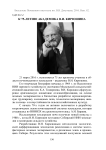Бюллетень Почвенного института им. В.В. Докучаева @byulleten-esoil
Статьи журнала - Бюллетень Почвенного института им. В.В. Докучаева
Все статьи: 567
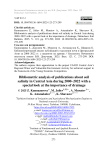
Статья научная
Soil salinity is a serious disaster in many arid and agricultural regions, especially in Central Asia. The extensive economic impact of soil salinization on the national economy of Central Asian countries is significant. To solve the above problem, three systems are of great importance: drainage system, high-quality land leveling (planning) and salt washing activities. The aim of this study to review published articles on the issue of the term of soil salinity regions in Central Asia from 2000 to 2022. Aligning with this aim, we have collected, reviewed, and analyzed 661 publications, met the selection criteria in the Scopus database during 2000–2022. Bibliometric analysis showed that all articles were published in English, with the highest publication numbers coming from the Uzbekistan, Kazakhstan, Germany, China, the Russian Federation and the United States. The bibliometric analysis showed that international research on soil salinity and importance of drainage system is needed to expand the scientific exchange on this topic, as well as long-term, continuous research and sustainable development of soil salinization concepts for future agriculture and soil salinity management integration will be useful.
Бесплатно
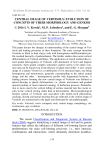
Central image of vertisols: evolution of concepts of their morphology and genesis
Статья научная
This paper discuss the changes in understanding of the central image of Vertisols and leading processes of their formation. The early concept described Vertisols as black or dark clayey soils with homogenous undifferentiated profile resulted basically of pedoturbation. The further studies discovered vertical differentiation of Vertisol attributes. The application of trench method discovered spatial heterogeneity of Vertisols with alternation of bowl and diapiric structures. Such spatial complex subsurface pattern seems to be rather common and can be found even in the absence of gilgai microrelief. A new central image of a mature Vertisol is a combination of two structural types, one being homogenous and monotonous, generally corresponding to the initial central image, and the other - heterogeneous profile with fragmented horizons. A leading process forming the new central image of Vertisols was defined as lateral shearing or plastic deformations, i.e., plastic movements and gradual upward pushing of moist material (analogy of defluction process). Pedoturbation or more exactly the vertical falling of surface material into the cracks results in the vertical mixing rather than in deformations. Micromorphological features typical of Vertisols and associated with shrink-swell phenomena, cracking, mixing and lateral shearing that are reflected in the central image of Vertisols are summarized in the paper and illustrated by microphotographs.
Бесплатно
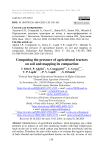
Computing the pressure of agricultural tractors on soil and mapping its compaction
Статья научная
Manufacturers of agricultural machines, when designing, pay a little attention to its impact on soil, thus producing models with high compression loads on the soil or with a small contact area between the tyres/tracks and the soil surface. Therefore, the aim of this study is to evaluate the negative impact of both wheeled and tracked agricultural tractors on the soil, in terms of soil compaction, and its causes (i. e. design features of tractor tyres/tracks), during the last six decades (i. e. from 1961 to 2021). Soil compaction is caused by the pressure applied by agricultural machines on the soil through the contact area of their tyres/tracks with the soil surface. So, the main indicator of the negative impact on the soil by the tractors manufactured during the last 60 years, i. e. the average pressure applied by the tyres or tracks of tractors manufactured in EU and in the post-Soviet cuntries from 1961 to 2021 to the soil, was computed. A general decrease of the average pressure of the tyres/tracks on the soil can be observed in 1980s and 1990s, followed by its general increase since 2000, above all for the tractors having power higher than 140 kW. Thus, there is an urgent need to assess spatial and temporal changes in soil vulnerability to compaction, that depends on weather conditions and soil properties, as well as agricultural management practices, and can only be fully assessed by means of a combination of traditional techniques (i. e. use of soil cone penetrometer followed by 2D mapping using GIS or 3D mapping through geostatistics) and mechanical approaches (i. e. computation of agricultural machine parameters - soil contact area). The results show that tractor manufacturers did not take care of reducing soil compaction during the considered period.
Бесплатно
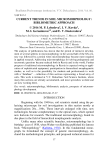
Current trends in soil micromorphology: bibliometric approach
Статья научная
The analysis of publications has shown that the period of intensive development of several spheres in micromorphology in the second half of the XX century was followed by a period when micromorphology became more required in applied research. Addressing micromorphology for solving pedogenetic and taxonomic questions became reduced both in Russia and in the world. Further progress of traditional micromorphology in Russia is expected owing to application of sophisticated equipment, participation in hierarchical morphogenetic studies, as well as to the possibility for students and professionals to work with a “database” - collection of thin sections representing a broad array of soils. This work is initiated at V.V. Dokuchaev Soil Science Institute, where many thin sections are already accumulated, and most specialists worked and are now working there.
Бесплатно
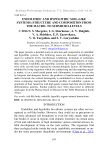
Статья научная
The paper presents a detailed study on structure and composition of endolithic and hypolithic systems. The following issues are discussed: morphology at macro to submicro levels, biochemical weathering, formation of carbonates and oxalates in situ, migration of Fe compounds, and spatial patterns of endolithic systems. Endolithic and hypolithic systems have major features attributed to soils: (a) rock layer exposed to external abiogenic factors, (b) lithomatrix inhabited by living organisms which are synthesizing and decomposing organic matter, (c) as a result initial parent rock (lithomatrix) is transformed in situ by biogenic and abiogenic factors, the products of transformation are retained and/or removed, the vertical heterogenity is established in a form of microhorizons composing microprofile. Examined profiles of endolithic systems in granitoids of East Antarctica with high quartz content had clear eluvial-illuvial differentiation patterns. Similar patterns have been discovered in different landscapes from the Plateau Ozark in Missouri to the Table Mountain in South Africa.
Бесплатно
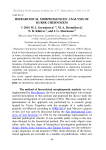
Hierarchical morphogenetic analysis of Kursk chernozem
Статья научная
Each of four hierarchical levels in the morphogenetic research is characterized in terms of technical and information facilities. A detailed hierarchical study was performed for the first time for chernozems and may be qualified for a basic one. Its results comprise confirmation of occurrence and details in manifestations of pedogenetic processes well-known in chernozems, as well as additional information on the pedofauna contribution to chernozem formation, variability and dynamics of carbonate pedofeatures, stability of the mineral soil ingredients.
Бесплатно
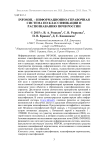
INFOSOIL - информационно-справочная система по классификации и распознаванию почв России
Статья научная
Информационная система INFOSOIL предназначена для построения целевых классификаций почв на основе фиксированного набора почвенных показателей. При этом обеспечивается прозрачность всех этапов и процедур: определяется предельное число объектов в учтенном пространстве признаков, информативность этих признаков, метод и качество группировок объектов в классы, осуществление распознавания вновь представленных почв. Система претендует называться генератором или машиной целевых классификаций почв. В основу системы положена концепция классификации-перечисления, связывающая совокупность значений почвенных признаков, соответствующих намеченной цели и назначению создаваемой классификации. Произведение числа значений (позиций классификаторов) признаков определяет максимальное число объектов в образованном классификационном пространстве. Достигается полное соответствие пространства признаков и числа объектов. Показана реализация предлагаемого подхода, а также указано положение известных почв в системе полученной целевой классификации. В статье демонстрируется первая версия сайта информационной системы (www.infosoil), показано развитие ее реальных возможностей и обеспечен доступ к средствам обновления разработчикам и авторам классификации. Предусмотрены интерфейсы с создаваемой Почвенно-географической базой данных, с Государственным реестром почвенных ресурсов, с Почвенной картой в масштабе 1 : :2500000. В систему по существу включена классификация (2004), которой можно пользоваться, а авторам созданы условия для ее развития. Автоматизировано использование определителя почв (2008). INFOSOIL развивается как интеллектуальная информационная система, включившая расчетно-логическую систему МЕРОН, алгоритмические средства создания классификаций перечисления, использования и исследования существующих классификаций.
Бесплатно
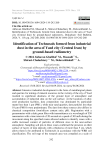
Статья научная
Intensive industrial development in the form of metallurgical plants and quarries for mining of mineral resources in the vicinity of the city of Yazd resulted in significant dustiness of the ground layer of atmosphere and accumulation of industrial dust on the soil surface. At the locations of alloy steel production facilities, dust composition was dominated by particulate matter less than 1 μm (PM1), while near sand quarries, dust particles less than 10 μm (PM10) were predominant. The dust from these sources also differs in chemical composition (iron/silicon content ratio, pH). Registration with a pyranometer with a dark green filter with transmittance at a wavelength of 550 nanometers with a time interval of 20 seconds at a speed of 30 km/h during the movement along the specified routes allowed authors to identify zones with a stable increased content of particles of different sizes in the near-surface atmosphere. Sampling soil pits in these zones confirmed the presence on their surface of layers of dust deposits with a thickness of more than 5 cm, which allows them to be attributed to Technosols in accordance with the WRB soil classification. The soil map of the research area was compiled at a scale of 1 : 25 000 with the reflection of Technosols participation in the soil patterns. According to the map, more than three quarters of the study area are soil complexes including Technosols. Arid climatic conditions of the region lead to the accumulation of dust on the soil surface, which are practically not transformed and not removed from the soil, which results in their degradation and deterioration of the environmental conditions. Dust accumulation on the soil surface affects the state of vegetation cover of the region, which serves as a basis for indirect satellite indication of dusting zones. The method of revealing the dust layer on the soil surface based on the assessment of dustiness of the near-surface atmosphere using pyranometer can serve as a good complement to remote sensing methods.
Бесплатно
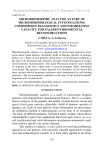
Статья научная
Microbiomorphic analysis is a detailed study of microscopic particles of biogenic nature (plant detritus, phytoliths, shells of diatoms, spicules of sponges, pollen, etc.). Each of such particles characterizes environmental conditions at the time of its formation and, therefore, provides useful information for palaeoenvironmental reconstructions. The Early Pleistocene deposits were studied in Armenia at the sites, where tools of ancient hominids (Early Acheulian) were found. The genesis of these deposits was identified. It was shown that these ancient alluvial-lacustrine sediments were transformed by soil-forming processes. The environmental conditions at the time of the ancient hominids’ migration were reconstructed.
Бесплатно
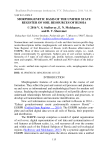
Morphogenetic basis of the unified state register of soil resources of Russia
Статья научная
Nomenclature and taxonomic diversity of soils and their horizon-profile diagnostics/descriptions define morphogenetic soil indicators used in the Unified State Register of Soil Resources of Russia (with Russian abbreviation of EGRPR). Most of these soil indicators are of non-metric origin, i.e., established conventionally by agreement. Subject area of soil science includes a hierarchy of 5 types of soil objects (pit, profile, horizon, morphological element and sample), 380 indicators, 607 methods and 3019 values of the indicators.
Бесплатно
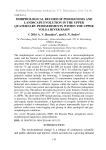
Статья научная
The morphological record of pedogenesis (mostly at a micromorphological scale) and the features of paleosols developed at the northern geographical extremity of the MIS3 paleopedoshpere (including the Bryansk fossil soils) are described. The profiles of the MIS3 paleosols (dark humic gley and peaty gley with the 14С-age around 29-50 cal kyr BP) are located within the periglacial zone in the centre of the Russian Plain (56.7°-58.5° N) within the Upper Volga drainage basin. An assemblage of stable micromorphological features of paleosols studied includes the following: 1) ferruginous nodules and other pedofeatures, occasionally fragmented; 2) concentration (separation) of sand grains within certain microzones; 3) inclusions of raw organic matter, often deformed and oriented to different degrees within the matrix. Despite being buried for a long time period and superimposed by the Holocene pedogenetic processes (clay illuviation), the paleosols preserve some features of short-term (101-102 yr) and medium-term (102-103-4 yr) elementary pedogenetic processes (EPP). The short-term EPP include gleying, structure forming and cryogenic processes. The medium-term EPP include humus formation, peat formation and organic matter accumulation. A hypothesis of cryogenic formation of the paleosols studied is substantiated. Only an almost impermeable layer of permafrost could cause water-logging and gleying in these geological and geomorphological conditions.
Бесплатно
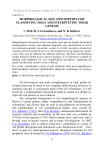
Morphological soil description for classifying soils and interpteting their genesis
Статья научная
Morphological description of the soil profile must provide further hierarchical morphogenetic analysis and adequate diagnostic and classification of soil in any substantive-genetic taxonomic system. In a brief taxonomy-oriented description, priority should be given to soil properties having diagnostic significance; they may be different for different horizons, and those discriminating similar horizons should receive special attention. It is proposed to compile an updated field handbook for soil morphological description, supporting the recent classification system of soils of Russia.
Бесплатно
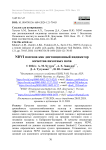
NDVI посевов как дистанционный индикатор качества пахотных почв
Статья научная
Качество пахотных почв во многом предопределяет урожайность сельскохозяйственных культур и экономическую эффективность их возделывания. Целью настоящей работы является анализ связи внутриполевых неоднородностей посевов с вертикальной неоднородностью скелетности почв на примере тестового поля с посевами кукурузы в Кабардино-Балкарии. В качестве индикатора состояния посевов использовался вегетационный индекс NDVI, рассчитанный по данным спутниковой съемки Sentinel-2. Скелетность почвы определялась методом сухого просеивания. Установлено, что значение индекса NDVI посевов на тестовом поле может служить основой для косвенного детектирования вертикальной неоднородности агрономически важных свойств почв. Для получения надежной информации необходим точный выбор времени получения значений NDVI и культуры, возделываемой на поле. Индикационная способность разных культур предопределяется их фенологией и мощностью потенциального корнеобитаемого слоя. География агрономически важных свойств почв на тестовом поле не коррелирует с выделами традиционно составленной почвенной карты. Пространственное варьирование урожайности кукурузы на тестовом поле (размах 23%) коррелирует с варьированием по профилю скелетности почв. Для использования значений NDVI в качестве индикатора пространственного варьирования агрономически важных свойств почв необходим учет типа возделываемой культуры, тщательный выбор даты получения NDVI, а также наличие априорных экспертных знаний о лимитирующих почвенных факторах на поле, специфики фенологии и агротехнологии возделывания культуры.
Бесплатно
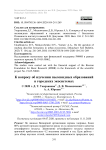
On the question of studying dust-like formations in urban ecosystems
Статья научная
According to the World Health Organization, more than 80% of urban residents are at risk due to unsatisfactory air quality and air pollution, which causes approximately 4.2 million deaths per year. The purpose of the work is to give an overview of scientific articles related to the dustiness of the city’s natural environments. The articles of foreign and Russian researchers were analyzed - the definition of urban road dust was given; the primary technogenic and natural sources of dust particle generation in the city, thephysical and chemical properties of road dust, their dependence on climate, the type of roads and city architecture, the effect of photolysis on physicalchemical characteristics of dust particles are reviewed as well. Particular attention is paid to the negative impact of dust particles PM2.5 and PM10 on human health and the environment. The question of the absence in Russian scientific practice an officially recognized methodology for the settled dust sampling with updating the regulatory documentation on the methodology for the sampling of fine particles suspended in the air is considered. Recommendations are given on the creation of the regulatory framework governing the sampling and analysis of road dust, which is confirmed by the numerous conclusions of both foreign and some domestic researchers as an environmental geo-indicator.
Бесплатно
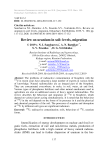
Review on uranium in soil: levels, migration
Статья научная
The problems of radioactive contamination of biosphere with the 238U in recent years have attracted a large number of experts in various fields of knowledge. Natural radionuclides are an integral part of the biosphere. They are concentrated everywhere: in rocks, in soil, water, air and food. Various types of phosphorus fertilizers and other natural ameliorants used in agriculture are also an additional source of heavy natural radionuclides. The review describes the behaviour and migration of 238U in biosphere, which depend on various factors acting simultaneously. It is noted that the behaviour of 238U in the soil depends on the forms of its presence in it and the physical and chemical properties of the soil. The processes of sorption and desorption of 238U by different soil types are significant indicators.
Бесплатно
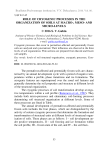
Role of cryogenic processes in the organization of soils at macro-, meso- and micro-levels
Статья научная
Cryogenic processes that occur in permafrost-affected and perennially frozen soils are analyzed and systematized. Their influences are observed at the three levels of soil organization. Thin sections are prepared from thawed and frozen soil samples.
Бесплатно
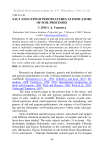
Salt and gypsum pedofeatures as indicators of soil processes
Статья научная
Pedofeatures of salts and gypsum in arid and semi-arid soils indicate the salinization process and its dynamics. Mineralogical and morphological features of these pedofeatures, their distribution in the soil profile as well as confinement to individual components of microstructure are indicators of soil processes, both modern and relict. The paper presents the results of a comprehensive morpho-mineralogical analysis of the newly formed salt and gypsum pedofeatures in saline soils in the south of European Russia and Cis-Baikal region as well as Transcaucasia, Central Asia, Kazakhstan and Mongolia.
Бесплатно
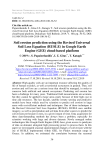
Статья научная
High-quality soils are an important resource affecting the quality of life of human societies, as well as terrestrial ecosystems in general. Thus, soil erosion and soil loss are a serious issue that should be managed, in order to conserve both artificial and natural ecosystems. Predicting soil erosion has been a challenge for many years. Traditional field measurements are accurate, but they cannot be applied to large areas easily because of their high cost in time and resources. The last decade, satellite remote sensing and predictive models have been widely used by scientists to predict soil erosion in large areas with cost-efficient methods and techniques. One of those techniques is the Revised Universal Soil Loss Equation (RUSLE). RUSLE uses satellite imagery, as well as precipitation and soil data from other sources to predict the soil erosion per hectare in tons, in a given instant of time. Data acquisition for these data-demanding methods has always been a problem, especially for scientists working with large and diverse datasets...
Бесплатно
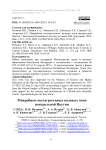
Soil microbiome of plaggic anthrosol and calcic cryosols in Central Yakutia
Статья научная
Soil microbiome makes a significant contribution to the implementation of ecosystem services, which are necessary for the sustainable functioning of ecosystems. Soils of central Yakutia develop under dynamic physical and chemical conditions (long-term freezing/thawing processes, redistribution of nutrients), which ensures the formation of a specific microbial community in natural and anthropogenically transformed areas. The object of the study was the natural, fallow, and agricultural soils of central Yakutia. The method of high-throughput sequencing of 16S rRNA gene fragment on Illumina MiSEQ sequencer was used to analyze the microbial community. As a result, in fallow lands a decrease in nutrients was revealed if compared to the lands involved in agricultural turnover. Based on the composition of the microbiome it was observed that the most common phyla are Acidobacteria, Actinobacteria, Verrucomicrobiota, Pseudomonadota (Alphaproteobacteria, Gammaproteobacteria), Bacterioidota, Chloroflexi, Planctomycetota. The presence of a core set of microorganisms for the studied soils was recorded, up to 17.8% of phylotypes are unique and up to 25.7% are common to fallow lands and background plots. Microbial communities vary depending on geographical locations and on types of natural resource use. The most distinct microbial communities are formed in hydromorphic soils with the development of gley processes, as well as in agricultural soils.
Бесплатно

